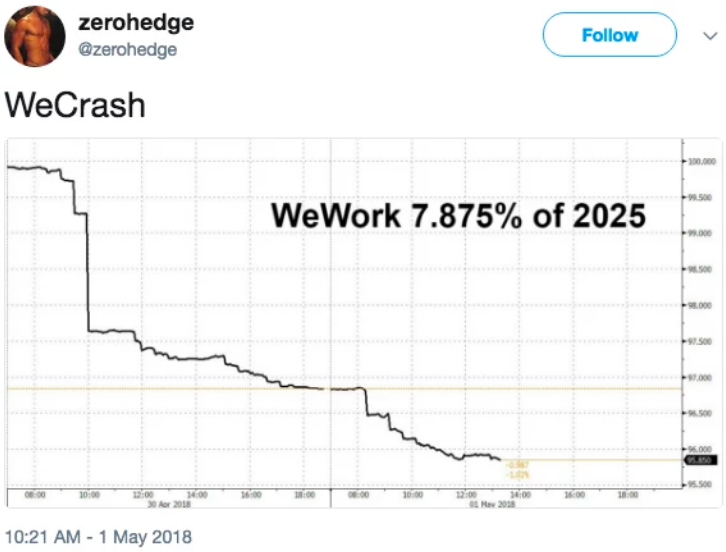The company missed estimates on both EPS and revenue. Total revenues were down 10.1% YOY. Total advertising revenues were down 16.7% YOY. Direct marketing advertising revenues declined 21.9% YOY. On the flip side, the company experienced growth in its digital initiatives, including increases in digital-only subscribers and average total unique visitors to online properties. The company also partnered with Subscribe with Google to push further improvements in the digital business. But, all in, this is a company that it is facing a massive wave of disruption coming at it from all angles.
First, its capital structure. The company’s leverage ratio stands at 4.42x as of the end of Q1 on the basis of its existing cap stack. Currently, it has about $30 million of outstanding letters of credit issued against its $65 million revolving credit facility (Bank of America). As of 12/31/17, the company had $344.6 million of 9% ‘22 senior secured first lien notes outstanding on top of (a) as of 4/27/18, $82.1 million of 7.15% ‘27 debentures and (b) $274 million of 6.875% ‘29 indentures.
But, not for long. Enter Chatham Asset Management. The fund — which may or may not be fresh off of a shiny new $1b private equity vehicle for debt-related investments — is taking out a large chunk of the capital structure. The company filed an 8k on April 26th, indicating that there is a term sheet pursuant to which a newly established LLC will issue $250 million of 7.372 % ‘30 Tranche A Term Loan paper and $168.5 million 6.875% ‘31 of Tranche B Term Loan paper, the proceeds of which will be used to take out the long-dated debentures (except $8.3 million) and a portion of the senior secured notes. The structure isn’t yet determined but the interest expense is expected to increase incrementally. There is a makewhole as well, as you might expect, and we’re guessing it will have some fairly iron clad verbiage. In other words, this reeks of loan-to-own — with a cherry on top (see #2 below). Perhaps Chatham will eventually roll up the properties with American Media Inc., parent to The National Enquirer, which Chatham owns 80% of and, per The Wall Street Journal, appears to be having issues of its own.
Some notable bits in the company’s earnings call:
A. Tariffs. Tariffs on newsprint may have an effect on traditional print media companies. Note the following comments:
One more word on the print newspaper world. We are often asked on these calls about the impact of newsprint prices on our operating model. As the print side of our business has declined so has our operating sensitivity to fluctuations in newsprint supply and pricing, now less than 4% of our operating expense, down from 20% at the peak of print newspaper revenues more than a decade ago.
Nonetheless, policies such as the newsprint tariffs announced by the administration earlier this year are unhelpful we believe, both to free market and to public policy. We oppose them and we have made our position clear to the administration. We say this as an equity owner of one of the few remaining U.S. domestic newsprint producers. So one might assume we would be on the other side of this issue, but we are not. Public policy that makes these input prices more costly at a time of great stress in this industry harms our local communities and is against the public interest.
Interesting. The company is guiding towards higher print costs, including increases in pricing coming from Canadian mills. #MAGA!!
B. Cost Controls. This company has all of the makings of a company in triage. Operating expenses were down 8.4%. The company outsourced printing operations. It entered into a sale leaseback transaction, pursuant to which $13 million of proceeds is being offered to the company’s senior secured noteholders in a tender offer at par. It sold off some intellectual property (CareerBuilder LLC). All of this is meant to buy the company time to effectuate its digital transformation.
C. Ad Spend. This should come as a surprise to nobody that follows the world of restructuring but the trickle-down effect of battered grocery and retail is notable here. This is the company’s statement about the higher-than-expected ad spend decline:
I mean retail results were disappointing. Obviously, that’s something that we’ve been seeing for some time now. Total retail revenues finished a bit better actually in Q1 and Q4, but that was driven entirely by digital growth. Revenue from preprints delivered with the newspaper actually got worse. And as Elaine said, our direct marketing circulars delivered to non-subscribers also softened. So our retail customers are facing some tough citing and it continues to have an impact on our print products. And some of those advertisers obviously in direct marketing are the same as the ones that are in the print newspaper, and their troubles affect both.
In retail print revenue, our largest declines were coming from the food and drug department store category, and we’ve seen that strand for a while. Preprints took a steeper decline in Q1. And then we’ve seen in previous quarters down about 38% over last year. Again though due to continued losses from the major department stores like Macy's, Sears, Stein Mart, Penne and stores no longer in business that were rolling over from last year like hhgregg and Toys "R" Us, or at least going in bankruptcy, Toys "R" Us is still struggling.
And so in preprints or about 12% of total advertising revenues, so when that gets hit that’s of percentage, it takes the whole category down. So mostly I think a story on the retail side, Avi, and continuing pressure on the print part of that business.
The company continued,
We sometimes talk about the importance of our role in local communities and with our neighbors, and these are the places we live where our employees are residents all across the country. The impact on local retail across the country has been, as you know, very widespread. This is an earnings call about a news and information company. So it’s the wrong place to talk about those underlying trends. But I would say we’re super aware of them. We obviously bare the impact from an advertising perspective, which also having a big impact on our communities. And that’s something that we’re extremely aware of as in many cases the leading local news and information company in those communities.
We appreciated the reminder. Jokes abound about the #retailapocalypse. For many local communities, the far-reaching effects of such are no laughing matter.



















